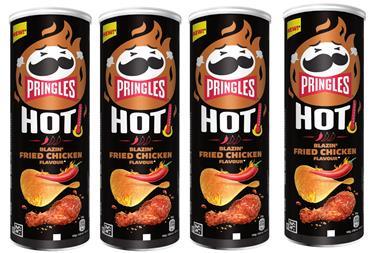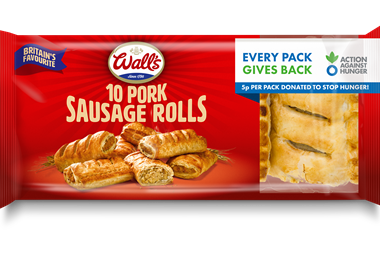Innovative packaging is extending the shelf-life of chilled and fresh products and making them more appealing, which is good news for retailers.
When Young’s Bluecrest approached Spar wholesaler AF Blakemore about trialling its chilled seafood range earlier this year, the wholesaler was sceptical, having unsuccessfully dabbled with chilled fish in the past. The difference this time, however, was that the range was available in new and innovative longer shelf-life packaging.
Young’s Bluecrest business manager, Colin Thurlby, comments: “AF Blakemore was unsuccessful in the past because the products they tried were relatively unknown and wastage was a big problem. So it took a bit of convincing to get them to trial our seafood range.”
Wastage is a problem that reverberates around the retail industry but is being actively addressed by suppliers.
Says Thurlby: “Packaging manufacturers and suppliers are working on new technology to increase the shelf-life of chilled and fresh products. The fact that the majority of our seafood range is now available in longer-life packaging should make it more appealing for c-stores.”
He continues: “We carried out a low-level launch at several Tates stores. There was no advertising because we wanted to see how well the products would sell on spec, and if there was any demand. The only shouting we did was on week four of the six-week trial, when seascape shelf-edge labelling was introduced.”
As it turned out the seafood products - which included seafood sticks, smoked mackerel fillets, kipper fillets, prawns in brine, rollmops and smoked salmon trimmings - proved more successful than expected, and AF Blakemore is now putting together a suitable range to be rolled out across its retail estate.
AF Blakemore marketing manager, Sarah Adkin, says: “This was our first major push for fresh fish - except for salmon, which we sell at Christmas. Sales were very encouraging during the trial, considering they were new products for us. A few items didn’t sell very well but we’re putting together a suitable range to roll out from those that did sell. Four stores will carry the range initially - within the next few weeks - and a further two before the end of the year.”
New packaging concepts that extend product life are making fresh products a more viable commodity for small retailers.
Packaging manufacturer Cryovac has recently launched Darfresh, which prolongs product shelf-life. Suitable for chilled and frozen ready meals, Darfresh is a ‘skin pack’. It helps preserve the food and consumers don’t have to pierce the lid when microwaving the product. The packaging is suitable for beef, pork, lamb, poultry and fish dishes that are cooked in a self-venting process.
Cryovac sales manager (retail), Sam Newman, comments: “Chilled ready meals usually stay fresh for around seven days, but with Darfresh this increases to 14, depending on the product. That’s not the only benefit for retailers: packs can be displayed horizontally or vertically, so there’s a lot of flexibility. For consumers there’s the advantage that the food doesn’t splatter when cooking.”
Darfresh is quite new to the industry and is currently being used for Kepak’s Global Cuisine range of chilled ready meals in the UK, and by Sveltesse, in France, for its frozen products.
Fresh fruit and vegetable supplier Redbridge has also been addressing the shelf-life issue. The company identified c-stores as a considerable growth opportunity, if only their products could mirror the quality available at supermarkets. Redbridge product group manager, Sally Cleary-Corbett, explains: “We wanted to develop a product for c-stores that mimicked the supermarkets: with a high specification and extended shelf-life to reduce wastage.”
It’s taken the company two years, but it has finally come up with an effective packaging solution for c-stores. Cleary-Corbett continues: “The average shelf-life of fresh fruit and vegetables is currently three to five days, but we’ve extended this to seven. The trouble is, each variety of fruit and vegetable respires at a different rate and so needs a different type of film to preserve it. We’ve carried out extensive trials to match the right film to the right product - the film was already available, we’ve just married it up with the right fruit and vegetables.”
Redbridge has now put together a fresh fruit and vegetable range for the c-store market. Products available include twin-packs of apples, grapes, prepared salad mixes, cherry tomatoes, lemons, pears, cauliflower and cabbage. These are being marketed to distributors under Redbridge’s ‘5 A Day’ brand, and will be followed by a food to go range in the future once the core range has been established.
But extending shelf-life isn’t the only issue facing packaging manufacturers. There’s also the question of innovation, to keep up the momentum on ‘convenient’ product development, as well as creating visual appeal to suit individual products.
Cryovac has been working with fresh vegetable supplier, Florette, to produce packaging that steams the vegetables. ‘Heavenly Veg’ is a premium product consisting of prepared vegetables and a sauce. The packaging is layered, with the vegetables on the top and a sauce below. The ‘disposable steamer’ cooks the vegetables in the microwave and the sauce can be added afterwards. The ‘steamer’ even has flip-up handles for ease of use.
Florette’s commercial director, Sandy Sewell, says: “The idea behind Heavenly Veg was to offer an ingenious ready-prepared vegetable, which we’ve achieved. Florette is known and trusted by consumers, and our branding and packing plays an important part in our product identity in all retail sectors, especially convenience stores. Freshness, quality and innovation, which are all hallmarks of Florette, are present on-pack as well as in the products themselves.”
He adds: “Florette’s packaging is now more transparent, with clear display panels allowing consumers to view our salad mixes, recipes and interesting leaf combinations. The company has pioneered many packaging ‘firsts’, including sachets in-pack, fork indents for salad bowls, and new square-shaped salad ‘pillow’ bags and bowls, for better shelf-display and leaf protection.”
Meanwhile, supplier of low-fat cakes and chilled savouries, Anthony Alan Foods, recently introduced counter display units (CDUs) for its range of Weight Watchers chilled savouries in reaction to market pressures. The CDUs were developed in smaller, more attractive, packaging formats with the c-store and fast food sector in mind, where space is normally quite limited.
The company usually carries out 12-month reviews on packaging but is constantly looking at how products are doing. It takes around two months to implement packaging changes.
Anthony Alan Foods operations director, (chilled and fresh packaging), Matt Carr, says: “We are constantly reacting to market conditions. Retailing is one of the most aggressive markets in the world and of all countries this is the most aggressive worldwide.
“We know retailers are under pressure to increase sales and we want to help them as much as we can. This means we’re having to innovate continuously.”
When Young’s Bluecrest approached Spar wholesaler AF Blakemore about trialling its chilled seafood range earlier this year, the wholesaler was sceptical, having unsuccessfully dabbled with chilled fish in the past. The difference this time, however, was that the range was available in new and innovative longer shelf-life packaging.
Young’s Bluecrest business manager, Colin Thurlby, comments: “AF Blakemore was unsuccessful in the past because the products they tried were relatively unknown and wastage was a big problem. So it took a bit of convincing to get them to trial our seafood range.”
Wastage is a problem that reverberates around the retail industry but is being actively addressed by suppliers.
Says Thurlby: “Packaging manufacturers and suppliers are working on new technology to increase the shelf-life of chilled and fresh products. The fact that the majority of our seafood range is now available in longer-life packaging should make it more appealing for c-stores.”
He continues: “We carried out a low-level launch at several Tates stores. There was no advertising because we wanted to see how well the products would sell on spec, and if there was any demand. The only shouting we did was on week four of the six-week trial, when seascape shelf-edge labelling was introduced.”
As it turned out the seafood products - which included seafood sticks, smoked mackerel fillets, kipper fillets, prawns in brine, rollmops and smoked salmon trimmings - proved more successful than expected, and AF Blakemore is now putting together a suitable range to be rolled out across its retail estate.
AF Blakemore marketing manager, Sarah Adkin, says: “This was our first major push for fresh fish - except for salmon, which we sell at Christmas. Sales were very encouraging during the trial, considering they were new products for us. A few items didn’t sell very well but we’re putting together a suitable range to roll out from those that did sell. Four stores will carry the range initially - within the next few weeks - and a further two before the end of the year.”
New packaging concepts that extend product life are making fresh products a more viable commodity for small retailers.
Packaging manufacturer Cryovac has recently launched Darfresh, which prolongs product shelf-life. Suitable for chilled and frozen ready meals, Darfresh is a ‘skin pack’. It helps preserve the food and consumers don’t have to pierce the lid when microwaving the product. The packaging is suitable for beef, pork, lamb, poultry and fish dishes that are cooked in a self-venting process.
Cryovac sales manager (retail), Sam Newman, comments: “Chilled ready meals usually stay fresh for around seven days, but with Darfresh this increases to 14, depending on the product. That’s not the only benefit for retailers: packs can be displayed horizontally or vertically, so there’s a lot of flexibility. For consumers there’s the advantage that the food doesn’t splatter when cooking.”
Darfresh is quite new to the industry and is currently being used for Kepak’s Global Cuisine range of chilled ready meals in the UK, and by Sveltesse, in France, for its frozen products.
Fresh fruit and vegetable supplier Redbridge has also been addressing the shelf-life issue. The company identified c-stores as a considerable growth opportunity, if only their products could mirror the quality available at supermarkets. Redbridge product group manager, Sally Cleary-Corbett, explains: “We wanted to develop a product for c-stores that mimicked the supermarkets: with a high specification and extended shelf-life to reduce wastage.”
It’s taken the company two years, but it has finally come up with an effective packaging solution for c-stores. Cleary-Corbett continues: “The average shelf-life of fresh fruit and vegetables is currently three to five days, but we’ve extended this to seven. The trouble is, each variety of fruit and vegetable respires at a different rate and so needs a different type of film to preserve it. We’ve carried out extensive trials to match the right film to the right product - the film was already available, we’ve just married it up with the right fruit and vegetables.”
Redbridge has now put together a fresh fruit and vegetable range for the c-store market. Products available include twin-packs of apples, grapes, prepared salad mixes, cherry tomatoes, lemons, pears, cauliflower and cabbage. These are being marketed to distributors under Redbridge’s ‘5 A Day’ brand, and will be followed by a food to go range in the future once the core range has been established.
But extending shelf-life isn’t the only issue facing packaging manufacturers. There’s also the question of innovation, to keep up the momentum on ‘convenient’ product development, as well as creating visual appeal to suit individual products.
Cryovac has been working with fresh vegetable supplier, Florette, to produce packaging that steams the vegetables. ‘Heavenly Veg’ is a premium product consisting of prepared vegetables and a sauce. The packaging is layered, with the vegetables on the top and a sauce below. The ‘disposable steamer’ cooks the vegetables in the microwave and the sauce can be added afterwards. The ‘steamer’ even has flip-up handles for ease of use.
Florette’s commercial director, Sandy Sewell, says: “The idea behind Heavenly Veg was to offer an ingenious ready-prepared vegetable, which we’ve achieved. Florette is known and trusted by consumers, and our branding and packing plays an important part in our product identity in all retail sectors, especially convenience stores. Freshness, quality and innovation, which are all hallmarks of Florette, are present on-pack as well as in the products themselves.”
He adds: “Florette’s packaging is now more transparent, with clear display panels allowing consumers to view our salad mixes, recipes and interesting leaf combinations. The company has pioneered many packaging ‘firsts’, including sachets in-pack, fork indents for salad bowls, and new square-shaped salad ‘pillow’ bags and bowls, for better shelf-display and leaf protection.”
Meanwhile, supplier of low-fat cakes and chilled savouries, Anthony Alan Foods, recently introduced counter display units (CDUs) for its range of Weight Watchers chilled savouries in reaction to market pressures. The CDUs were developed in smaller, more attractive, packaging formats with the c-store and fast food sector in mind, where space is normally quite limited.
The company usually carries out 12-month reviews on packaging but is constantly looking at how products are doing. It takes around two months to implement packaging changes.
Anthony Alan Foods operations director, (chilled and fresh packaging), Matt Carr, says: “We are constantly reacting to market conditions. Retailing is one of the most aggressive markets in the world and of all countries this is the most aggressive worldwide.
“We know retailers are under pressure to increase sales and we want to help them as much as we can. This means we’re having to innovate continuously.”























No comments yet